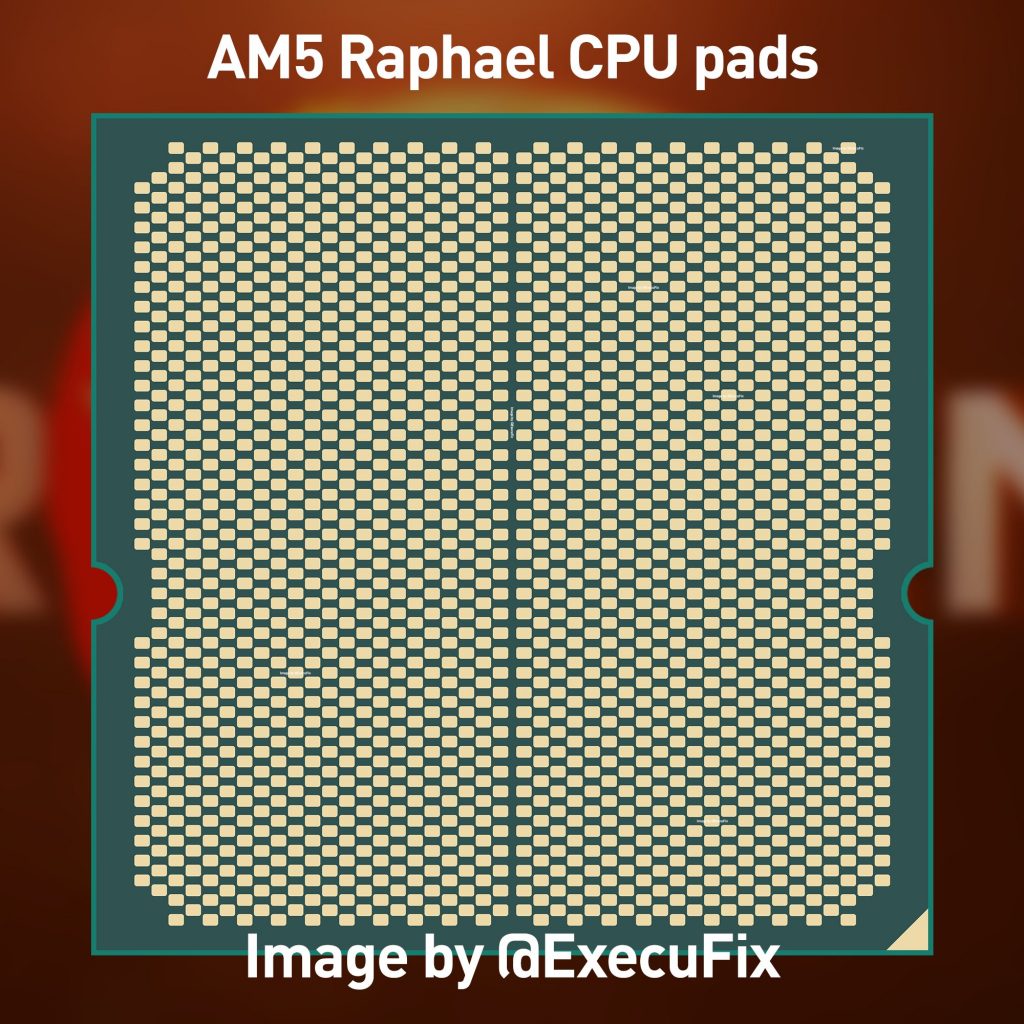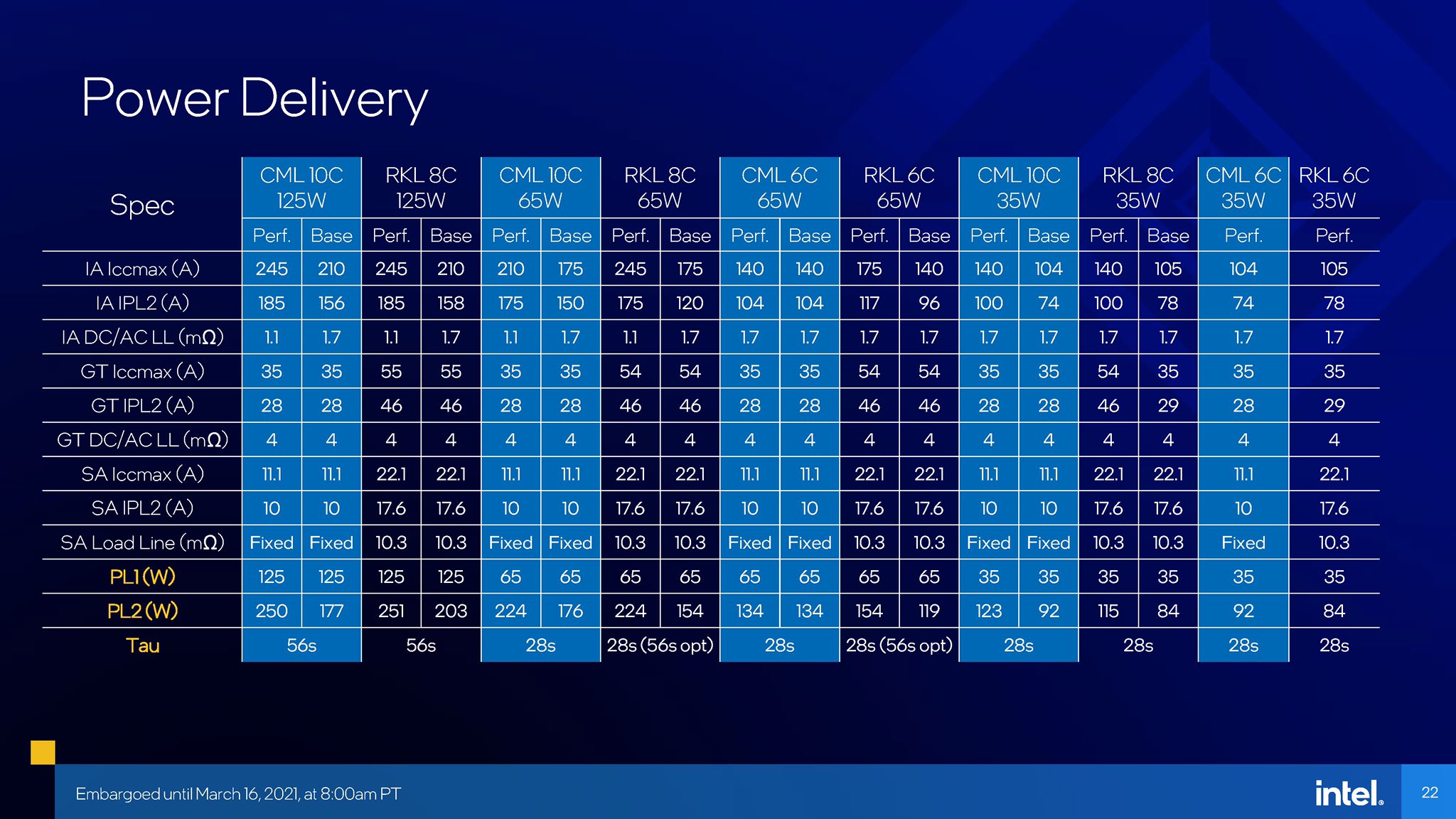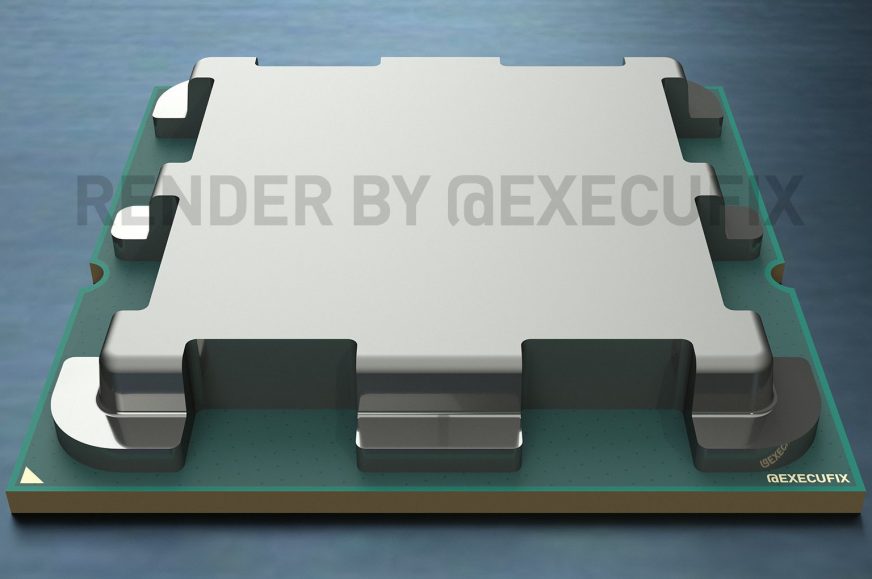The first shot of the processor for socket AM5, and higher TDP for Ryzen Raphael chips
We have recently covered the first info detailing the new AMD desktop platform for Ryzen 6000 processors (or 7000, we’ll see) that will introduce DDR5 memory. The source of this report has now provided more on the connectivity specs, as well as a picture showing what the processors for the AM5 socket might look like. But it also looks like the TDP will increase, perhaps due to the TDP increasing strategy of Intel’s.
The leaker going by ExecutableFix says on Twitter that the first processor with Zen 4 cores for the consumer market will be Ryzen codenamed Raphael, which should use 5nm chiplets. It does not necessarily have to be the first processor for the AM5 socket, that is not being stated (it is possible that a 6nm desktop version Rembrandt APU with Zen 3 cores will be released before it).
ExecutableFix also showed a picture showing what the Raphael processor will look like from the bottom where the contact pads are. This is a not a photo or official image from AMD, it is a manually made mock-up, which ExecutableFix probably created from bits of Epyc or Threadripper official render. However, he probably based the form of a package and contact surfaces from some internal documents containing a diagram. He did the same for the image of 5nm Epyc Genoa, which he showed three months ago.
Read more: Info on AMD AM5: the new socket is LGA without pins, only PCIe 4.0
The processor, which is supposed to have a size of 40 × 40 mm (for comparison, an LGA 1700 Alder Lake processor will be rectangular with 37.5 × 45.0 mm dimensions), it seems to have pads all over itsbottom, so there will be no empty window with SMD components in the middle, which characteristic of Intel processors. These will therefore have to be mounted around the chip on top (which will be a great complication when delidding). Even layout could help distribute the pressure that the cooler will create. As stated last time, the number of pads is to be 1718.

AM5: no DDR4 compatibility, more PCIe lanes
In addition to this interesting fact (we shall see how much is the form of this “mock-up” going fit the actual design later), ExecutableFix more importantly has new details about the technical specifications of the Raphael processor and the AM5 socket.
The first is that Ryzen “Raphael” processors will only support DDR5 memory, so there’s no DDR4 compatibility. Intel’s Alder Lake is supposed to still support it, thanks to which it will be possible to produce LGA 1700 motherboards for both DDR5 and DDR4 memory types (as was the case with Skylake and DDR4/DDR3). This will not be possible on the AM5 platform with Ryzen CPUs, they do not retain compatibily with DDR4 in any way.
The good news is that four extra PCIe 4.0 lanes will be routed from the processor (PCIe 5.0 will not be supported by CPUs and motherboards, at least for the first generation, which was a key finding of a previous leak). Ryzen 3000 and 5000 provide a total of 24 lanes: ×16 for GPU, ×4 for SSD and another ×4 for chipset connectivity (these are therefore not counted towards usable connectivity). The Raphael processor should have 28 lanes.
PCIe 4.0 ×16 for the graphics will probably remain as is. We don’t know yet how the rest will be divided. Either two PCIe 4.0 ×4 interfaces for SSDs (and four lanes for the chipset) will be provided directly from the socket and the CPU, or there will still be only one ×4 interface for an SSD and AMD will provide more lanes for connecting the chipset, which would thus get PCIe 4.0 ×8 interface. This is already the case for TRX40 with Threadrippers and Intel also plans 4.0 ×8 PCIe connection toi chipset for Alder Lake CPUs on LGA 1700. AMD may increase this connection bandwidth to the chipset as well, which would gain a theoretical bandwidth of 16 GB/s compared to 4 GB/s on B550/A520 and 8 GB/s on X570 (note that all these values are fully duplex).
Let's keep it going! Raphael is the first Zen 4 consumer chip and here's a first look
Raphael
– AM5 socket
– DDR5 (no DDR4)
– 28 PCIe 4.0 lanes (+4 compared to Zen 3)
– 120W TDP (170W possible as well ?) pic.twitter.com/5DcTmjdqNd— ExecutableFix (@ExecuFix) May 25, 2021
Higher TDP, unfortunately
ExecutableFix also states that Ryzen Raphael will have a higher TDP than today’s Ryzen. AMD is setting those to either 65W TDP or 105W for higher performance models in current processors (it must be said that if cooling allows, boost power consumption is higher, up to 88 W, or up to 142 W for “105W” models, which is the so-called PPT limit). Then there are the lower TDP models – 35W and 45W, but these are not widely available, they are for the OEM market.
Raphael will reportedly have 120W TDP. This could perhaps be the value for the higher performance models that consume 105 W today. The question is whether the PPT will also increase, i.e. the maximum boost power. If the same ratio were maintained (105/142 = approx. 1.35×), then the real maximum boost power consumption could be up to 162 W. However, a 120W TDP would guarantee that if you had a cooler that could only handle by 120 W of heat output, then the processor should self-regulate to lower performance for such a cooler to suffice.
The lower TDP values are said to remain the same as for the Ryzen 3000 and 5000, so perhaps the easier-to-cool 65W models and also 45W “E” models (and perhaps GE models for 35W APU) will keep being offered.
The rest of the TDP numbers are the same as Vermeer/Matisse
— ExecutableFix (@ExecuFix) May 25, 2021
170W models?
It is even mentioned that in addition to the 120W value, even 170W TDP is supposedly going to be used (that would make PPT 230 W, while maintaining the same factor). But the 170W TDP is not supposed to be a regularly used value, it is said that only some special or high-end models might use it. Interestingly, there were reports that increasing TDP was also considered by Intel (where it is said that 150W TDP was or is being considered for some models on the LGA 1700/Alder Lake platform). It is therefore possible that this could be a response to similar move by Intel.
Actually, even increasing the TDP from 105 W to 120 W may already be a reaction to Intel’s policy in recent years. Its CPUs have 65W and 125W TDP, but Intel specifies much higher power consumption for boost (so-called PL2), up to 250 W. According to the original intention, it was to only last a limited time (28 s, 56 s), but today the situation is that motherboards often allow this high power consumption and PL2 to be consumed for indefinite time, which Intel willingly tolerates. So today, Intel processors can often consume up to 160–200 or more Watts permanently (even the SKUs officially rated for 65W TDP, which means that real consumption is more than triple of what is specified).

Read more: We know the PL2 of Intel Rocket Lake processors: boost power draw up to 251 W
Has Intel’s policy made AMD increase PL2?
This has direct impact on the competition. If Intel allows processors to consume 200 W or more and AMD processors are tightly limited to 142 W (105 W) or only 88 W (65 W models), then multi-threaded performance is not an fair battle. At the same power consumption, Intel’s multi-threaded performance would be much lower, as the CPU would have to run at a lower frequency. By unleashing the power consumption, Intel is also driving up performance. And it’s not only a problem in those case when the motherboard allows the temporary turbo to be used indefinitely. Many of the benchmarks used in reviews can be completed in a minute or half a minute, for which the high consumption lasts even on more restriced boards, so Intel’s benchmark results still benefit from it.
Unfortunately, due to this AMD also has an incentive to increase power consumption so as not to unnecessarily leave the potential of silicon untapped – because if you let the 16-core Ryzen 9 3950X or 5950X to eat 200 W too, their multi-threaded performance should jump much higher, as multi-core models are quite limited by the power consumption limit. Unfortunately, it seems that Intel’s high power consumption (which was previously widely criticized on AMD FX processors, but ironically those have already been surpassed by Intel in terms of power draw), has largely been accepted as something that is “normal” and not a problem by many buyers. Today customers, or at least those Intel-leaning, don’t seem to mind power-hungry CPUs. For a while now, this situation has been posing a risk that AMD will also one day decide that keeping power consumption low does not bring it any benefits and will also increase it to take this advantage away from Intel. Unfortunately, the current report seem to be confirming these concerns.
We can only hope that the computer world stops tolerating high power consumption this generously, or at least that AMD will not ramp the watts up as much as Intel. It would be much better if CPU manufacturers were pushed to the the opposite, to gradually reduce power draw and improve efficiency. Rather than increasing power consumption, it would be good if those maximum values (PPT on AMD) were stated in the specifications for better buyer awareness, or if they were ideally the same as TDP.
Update: more Raphael CPU mock-up images
After the original publication, the same leaker have provided more mock-up images, this time 3D renders of the top side of the CPU with the integrated heat spreader (a.k.a. lid) shown. These are again no official photos or renders, ExecutableFix has made them based on the shape detailed in AMD’s documents. Real look could differ in details.
This is how Raphael will look like from the top. AM5 sure has an interesting design ?
This took me some time to make and I'm quite pleased with the end result ? pic.twitter.com/TiWpE1VXQZ
— ExecutableFix (@ExecuFix) May 30, 2021
Sources: ExecutableFix (1, 2, 3)
Translated, original text by:
Jan Olšan, editor for Cnews.cz








